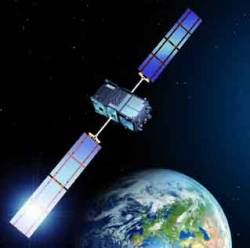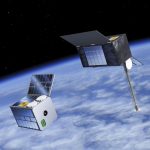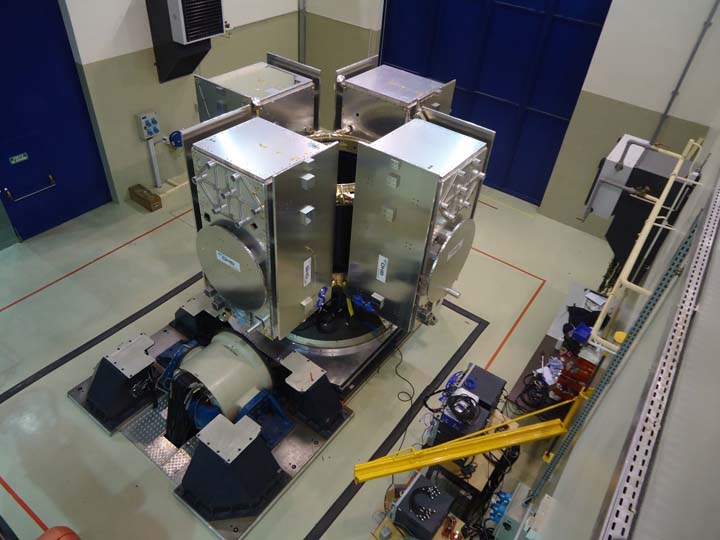 The first two of four Galileo In-Orbit Validation satellites are due for launch in August 2011. ESA illustration
The first two of four Galileo In-Orbit Validation satellites are due for launch in August 2011. ESA illustrationEurope’s GNSS system is still six months away from first launch of its in-orbit validation (IOV) spacecraft, but one Galileo satellite has already been put through its paces, taking center stage in a Europe-wide exercise conducted recently by the European Space Agency (ESA).
The satellite in question never left the confines of its Thales Alenia Space (TAS) integration facility in Rome, Italy, but was connected to a distant trio of control centers during the nine-day System Compatibility Test Campaign (SCTC-1), which began on January 25.
Europe’s GNSS system is still six months away from first launch of its in-orbit validation (IOV) spacecraft, but one Galileo satellite has already been put through its paces, taking center stage in a Europe-wide exercise conducted recently by the European Space Agency (ESA).
The satellite in question never left the confines of its Thales Alenia Space (TAS) integration facility in Rome, Italy, but was connected to a distant trio of control centers during the nine-day System Compatibility Test Campaign (SCTC-1), which began on January 25.
These same sites will oversee the satellite for real following its launch this August on a Soyuz rocket from Europe’s Spaceport in French Guiana, along with a second Galileo satellite. Despite their name and test demonstration role, the IOV satellites will become part of the full operational capability (FOC) constellation of 27 satellites plus three on-orbit spares.
“For a typical ESA mission there’s a single control center — usually ESA’s European Space Operations Center, ESOC, in Germany,” says Sandro Matussi, head of operations for ESA. “But Galileo is a much larger-scale undertaking with a control segment that extends across Europe.
The SCTC-1 exercise marked the first time that all the geographically dispersed control centers came together to work with an actual Galileo flight model, according to the officials.
The Toulouse control center, operated by French space agency CNES, has responsibility for the Galileo satellites throughout their launch and early operations phase (LEOP), with backup from ESOC. In practice, such activities as separation from the Soyuz upper stage, deployment of solar arrays, and the gradual activation of platform systems comprise the LEOP stage.
Once LEOP is completed, the satellites will be handed over to the Oberpfaffenhofen Galileo Control Centre near Munich in Germany, operated by the German Aerospace Center, DLR.
Operating the satellite payloads to provide navigation services will be the task of the Fucino Control Center east of Rome in Italy, operated by Telespazio. Fucino facility’s responsibilities include generating the navigation and integrity messages for embedding within Galileo signals.
“One center controls the satellite, the other makes sure of the signals reaching the ground,” said Sandro. “Without both of them working together in a closed-loop, Galileo would be useless.”
The SCTC-1 exercise serves to ensure that these facilities, with their different cultures and operating traditions, will function together as required.
The satellite was controlled from Toulouse for the first two days of LEOP simulation, before switching to Oberpfaffenhofen and Fucino for operational testing, including actual activation of satellite devices such as gyroscopes and reaction wheels as well as the payload units.
The final two days were devoted to “end-to-end testing’”– disseminating navigation and integrity messages from Fucino to the satellite and on to test receivers beside the satellite.
“We compared the signal uplinked to the satellite to the one downlinked back,” said ESA’s Edward Breeuwer, Galileo assembly integration and verification manager.
ESA performed successful tests of the Galileo civil open service, the safety of life service, and the encrypted public restricted service (PRS). The next SCTC will test the commercial service planned for the European GNSS.
More than 50 personnel across the three ESA sites plus the TAS plant in Rome took part in SCTC-1. SCTC-2 is scheduled for May, using the other Galileo satellite that will be included in the dual launch of August 2011.





